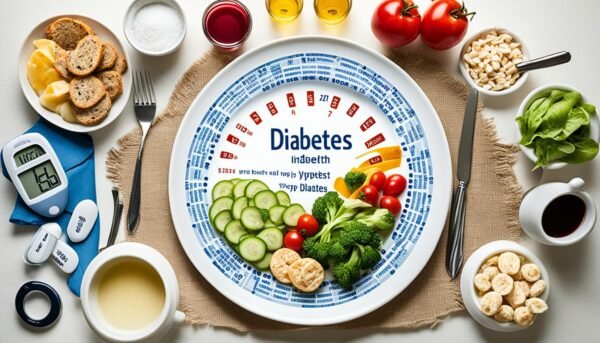I’ve lived with type 2 diabetes for over a decade. I know the daily challenges of managing this condition. It involves monitoring my blood sugar and navigating nutrition. But, I’ve found that low-carb foods are a powerful tool in my diet.
For people with type 2 diabetes, managing carbs is key. Too many carbs can raise blood sugar, causing highs and lows. By choosing low-carb superfoods, we can control our health and lower the risk of serious problems. In this guide, I’ll share the best low-carb foods that have helped me. I hope they can help you too.
Key Takeaways
- Low-carb diets can be an effective tool for managing type 2 diabetes by helping to regulate blood sugar levels.
- Incorporating a variety of nutrient-dense, low-carb foods like leafy greens, berries, and healthy fats can provide numerous health benefits.
- Learning to identify and limit high-carb foods that spike blood sugar is crucial for those with type 2 diabetes.
- A well-planned low-carb diet can lead to weight loss, improved cholesterol levels, and a reduced risk of diabetic complications.
- Consulting with a healthcare professional is recommended when transitioning to a low-carb lifestyle to ensure it’s done safely and effectively.
What is Type 2 Diabetes and How Does Food Affect It?
Type 2 diabetes is a condition where the body can’t handle carbohydrates well. This leads to high blood sugar levels. It’s different from type 1 diabetes, where the body can’t make insulin at all.
Understanding the Role of Carbohydrates in Diabetes
Carbohydrates greatly affect blood sugar levels for people with type 2 diabetes. They turn into glucose after we eat them, which goes into our blood. Normally, insulin helps control blood sugar. But for those with type 2 diabetes, insulin doesn’t work right, causing blood sugar to go up and down.
The Impact of High and Low Blood Sugar Levels
Keeping blood sugar levels healthy is key for managing type 2 diabetes. High blood sugar can cause nerve damage, vision issues, and increase heart disease risk. On the other hand, low blood sugar can make you dizzy, confused, and even cause seizures. Knowing how carbs affect blood sugar helps in making better diet choices.
By learning more about carbohydrates, people can control their diet and health better. Staying within a stable blood sugar range lowers the risks of type 2 diabetes and boosts overall health.

Can a Very Low-Carb Diet Help Manage Diabetes?
Many studies show that low-carb diets help manage type 2 diabetes. Before insulin was found in 1921, very low-carb diets were the main way to treat this condition. This shows how important carb restriction has been in diabetes care for a long time.
Historical Perspective on Low-Carb Diets for Diabetes
Before insulin was found, doctors knew controlling blood sugar was key for diabetes. They used low-carb diets to limit carbs, which affect blood sugar the most. These diets helped manage diabetes symptoms before insulin was available.
Long-Term Benefits of Carb Restriction
Recent studies show low-carb diets offer long-term benefits for type 2 diabetes. By eating fewer carbs, people can keep their blood sugar stable. This might mean needing less medicine and a lower risk of diabetes problems. But, sticking to a very low-carb diet can be hard, so it’s important to find what works best for each person.
“A very low-carb diet can be an effective tool for managing type 2 diabetes, but it requires commitment and may not be suitable for everyone in the long run.”
As research grows, it’s clear that low-carb diets have a strong history in diabetes care. They offer big benefits over time if followed well. But, finding what works best and getting support is key for lasting success.

What’s the Optimal Carb Intake for Type 2 Diabetes?
Managing type 2 diabetes means figuring out the right amount of carbs to eat. Some studies show that eating fewer carbs helps with blood sugar and weight. But, other research says eating 70–90 grams of carbs a day can also be good.
Everyone is different, so the best carb intake for type 2 diabetes varies. The American Diabetes Association suggests talking to your healthcare team to find what’s best for you.
| Carb Intake Approach | Potential Benefits |
|---|---|
| Very Low-Carb (20g per day) | Significant improvements in blood sugar, weight, and other markers |
| Moderate Low-Carb (70-90g or 20% of calories) | Effective for blood sugar management and overall health |
Finding the right carb intake for type 2 diabetes is personal. It’s important to work with your healthcare provider. This way, you can manage your blood sugar and improve your health.

“The ideal carb intake for people living with diabetes is a controversial topic, but the most important thing is to work closely with your healthcare team to find what works best for you.”
Identifying Carbs That Raise Blood Sugar Levels
Managing type 2 diabetes means knowing how different carbs affect your blood sugar. Some carbs can really spike your blood sugar, while others don’t have as big an effect. By knowing which carbs raise your blood sugar, you can choose better foods to help control your diabetes.
Understanding Net Carbs and Their Limitations
In plant-based foods, carbs include starch, sugar, and fiber. The starch and sugar can raise your blood sugar, but fiber doesn’t turn into glucose. To find the “net carbs,” subtract fiber and sugar alcohols from the total carbs. But, the FDA and the American Diabetes Association say not to just look at net carbs. They warn that this method might not always show how a food affects your blood sugar.
| Carb Type | Impact on Blood Sugar |
|---|---|
| Starch | Raises blood sugar significantly |
| Sugar | Raises blood sugar significantly |
| Fiber | Does not raise blood sugar |
Net carbs can be useful, but they have limits. It’s key to look at the quality and makeup of carbs you eat. By focusing on carbs that raise blood sugar, you can make smarter food choices. This helps you manage your type 2 diabetes better.
“The FDA and the American Diabetes Association do not recommend using the net carb tool to calculate carb intake for blood sugar management, as it may not be accurate.”
best low-carb foods for type 2 diabetes
Keeping a healthy diet is key for managing type 2 diabetes. Focusing on low-carb foods can really help. I’ve seen how a low-carb lifestyle can make a big difference. So, I’m excited to share some top low-carb options that can help you manage your condition.
Foods to Eat Without Restriction
There are many low-carb foods you can eat freely. These include:
- Meat, poultry, and seafood, which are great for protein and low in carbs.
- Eggs, a versatile and nutrient-rich food that won’t raise your blood sugar.
- Cheese, a source of healthy fats and few carbs.
- Non-starchy vegetables, like leafy greens, broccoli, and cauliflower, full of fiber and vitamins.
- Avocados and olives, offering healthy fats for overall health.
Foods to Consume in Moderation
Some low-carb foods are okay to eat freely, but others should be eaten in moderation. These include:
- Berries, a tasty and nutrient-packed fruit choice.
- Plain Greek yogurt, rich in protein and probiotics.
- Cottage cheese, a low-carb dairy choice.
- Nuts, giving you healthy fats and a crunchy snack.
- Milk and other fruits, enjoy them in moderation because of their sugar.
- Dark chocolate, a treat you can have a little bit because of its antioxidants.
The key to managing type 2 diabetes with a low-carb diet is finding balance. Add a variety of low-carb, nutrient-rich foods to your meals and snacks. This way, you can prevent health issues and keep your body strong. For more info, check out the Healthy Ideas Live website.

Foods to Limit or Avoid for Better Blood Sugar Control
Managing type 2 diabetes means watching what you eat. Foods high in carbs like white bread, pasta, and desserts can quickly raise your blood sugar. These foods are not good for people with diabetes.
To keep your blood sugar stable, try to limit or avoid these foods. Instead, eat more foods that are low in carbs but full of nutrients. Think about adding:
- Leafy greens
- Non-starchy vegetables
- Lean proteins
- Healthy fats
- Low-glycemic fruits
Watching how much carbs you eat and choosing wisely can help manage your blood sugar. It’s important to remember that everyone is different. Always talk to your healthcare team to find the best diet for you.
“Proper nutrition is the cornerstone of effective diabetes management. By limiting or avoiding the right foods, you can take a significant step towards better blood sugar control and overall well-being.”
| Foods to Limit | Foods to Avoid |
|---|---|
| White bread | Soda |
| Pasta | Beer |
| Refined cereal | Desserts |
| Corn | Baked goods |
| Starchy vegetables | Fruit juice |
A Sample Day of Very Low-Carb Meals
Starting a very low-carb diet for type 2 diabetes might seem hard, but planning can make it easier. Let’s look at a sample day of low-carb meals for diabetes. These meals are nutritious and help keep your blood sugar stable.
Breakfast Options
Begin your day with scrambled eggs with spinach. It’s a low-carb choice that gives you protein, healthy fats, and vitamins. Or try a veggie-packed omelet with some shredded cheese. These low-carb breakfast ideas will keep you full and ready for the day.
Lunch and Dinner Ideas
For lunch, a Cobb salad with grilled chicken, hard-boiled eggs, avocado, and a creamy dressing is great. Add roasted vegetables on the side for extra fiber and nutrients. For dinner, think about a grilled salmon fillet with roasted broccoli and cauliflower. Or go for a chicken Caesar salad with a creamy dressing and crisp romaine lettuce.
Everyone’s carb needs are different, so it’s key to work with your healthcare team to find what’s right for you. Trying out sample low-carb meals for diabetes can help you find the best balance for managing your blood sugar.
“The key to a successful low-carb diet for diabetes is finding a balance that works for you and your unique needs.”
Additional Resources for Low-Carb Diets
Starting a low-carb diet to manage type 2 diabetes? You’ll find many online tools to help you. Guides, trackers, and grocery lists can make sticking to a low-carb diet easier for better blood sugar control.
One top resource is the 5 simple steps to transform your. This article talks about the basics of a healthy life. It covers sleep, staying hydrated, exercising, eating right, and managing stress. Following these tips can lead to big health improvements.
For a deeper look at health and wellness, check out this guide on revamping your life with health and wellness. It explores mental health, stress, nutrition, and exercise. It offers a full approach to a balanced and happy life.
FAQ
What is type 2 diabetes and how does food affect it?
Type 2 diabetes means the body can’t handle carbs well. Carbs turn into glucose, which goes into the bloodstream. People with diabetes can’t keep blood sugar levels in check like others do.
Carbs have a big impact on managing blood sugar.
Can a very low-carb diet help manage diabetes?
Yes, many studies show that very low-carb diets help manage diabetes. Before insulin was found in 1921, these diets were a common treatment. They work well over time if followed closely.
What is the optimal carb intake for type 2 diabetes?
Finding the right carb intake for diabetes is tricky. Some research shows big improvements in blood sugar and weight on a diet with 20 grams of carbs a day. Others suggest 70–90 grams or 20% of daily calories from carbs is effective too.
Everyone reacts differently to carbs, so it’s personal.
How do I identify carbs that raise blood sugar levels?
Plant foods have carbs made of starch, sugar, and fiber. Only starch and sugar increase blood sugar. To find the carbs that affect blood sugar, subtract fiber and sugar alcohols from the total carbs.
What are the best low-carb foods for type 2 diabetes?
Good foods include meat, poultry, seafood, eggs, cheese, veggies, avocados, olives, and healthy fats. Eat berries, Greek yogurt, cottage cheese, nuts, milk, fruits, and dark chocolate in moderation.
What foods should I limit or avoid for better blood sugar control?
Avoid foods like white bread, pasta, refined cereal, corn, starchy veggies, juice, soda, beer, desserts, and baked goods. These can raise blood sugar a lot.
What does a sample day of very low-carb meals look like?
A day on a very low-carb diet might start with eggs and spinach for breakfast. Lunch could be a Cobb salad. Dinner might be a Cobb salad, chicken, and 85% dark chocolate.
Where can I find more resources for low-carb diets and type 2 diabetes?
There are many online resources for low-carb diets and type 2 diabetes. You can find guides, trackers, and grocery lists. These can help you follow a low-carb diet for better blood sugar control.
Source Links
- A Guide to Healthy Low Carb Eating with Diabetes – https://www.healthline.com/nutrition/low-carb-diet-for-diabetes
- Low Carbohydrate Diet for Type 2 Diabetes – https://www.med.umich.edu/1libr/PrimaryCare/LowCarbDietType2Diabetes.pdf
- Low-carb diet for diabetes: A guide and meal plan – https://www.medicalnewstoday.com/articles/325195
This post may contain affiliate links which means I may receive a commission for purchases made through links. I will only recommend products that I have personally used! Learn more on my Private Policy page.